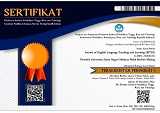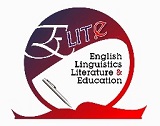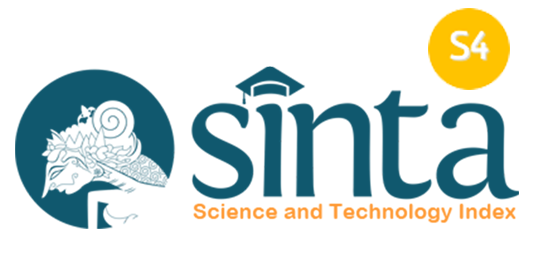Using Word Recognition Instruction and Visual Aids to Enhance Malaysian Primary ESL Learners’ Vocabulary Achievement
Abstract
Vocabulary is considered as an essential component of language teaching and learning, and its mastery is significant for all language learners. The process of learning vocabulary is sometimes referred to as vocabulary acquisition. In light of this, teachers need to conduct appropriate and enjoyable activities when teaching vocabulary. Effective techniques and interesting vocabulary materials are imperative especially for primary school ESL learners. This study aimed to determine the efficacy of employing word recognition instruction and visual aids in teaching action verbs to primary school learners in one of the primary schools in Semporna, Sabah, Malaysia. The overall number of participants in the research was 50, and they represented a mixed abilities group of learners. They were randomly assigned into experimental and control groups of 25. The experimental group used word recognition instruction and visual aids to learn new vocabulary (action verbs), while the control group used traditional memorisation instruction to learn the same vocabulary. Following these instructions, the two groups were evaluated (Post-test). The study's findings indicated that the experimental group outperformed the control group. Additionally, it recommends that English language teachers consider word recognition instruction and visual aids as successful vocabulary teaching strategies.
Keywords
Full Text:
PDFReferences
Blachman, B. A., & Tangel, D. M. (2008). Road to reading: A program for preventing and remediating reading difficulties. Paul H. Brookes Pub. Co.
Blachowicz, C. L., & Fisher, P. R. (2004). Vocabulary lessons. Educational Leadership, 61(6), 66.
Boualleg, R. (2016). The use of pictures in teaching vocabulary in EFL middle school classes [Mohamed Kheider University of Biskra]. http://archives.univ-biskra.dz/bitstream/123456789/8814/1/a133.pdf.
Çelik, S., & Toptaş, V. (2010). Vocabulary learning strategy use of Turkish EFL learners. Procedia - Social and Behavioral Sciences, 3, 62–71. https://doi.org/10.1016/j.sbspro.2010.07.013
Chai, Z. F., & Swanto, S. B. (2020). The effects of environmental problem-based learning method on Malaysian primary ESL learners’ vocabulary achievement. Indonesian TESOL Journal, 2(1), 59–70. https://doi.org/10.24256/itj.v2i1.1086
Chwo, S.-M. G., Marek, M. W., & Wu, W.-C. V. (2016). Curriculum integration of MALL in l1/l2 pedagogy: perspectives on research. Journal of Educational Technology & Society, 19(2), 340–354.
Dakhi, S., & Maritha, E. (2018). The effectiveness of picture: an empirical evidence in vocabulary mastery. JET (Journal of English Teaching), 3(3), 163. https://doi.org/10.33541/jet.v3i3.757
Fuchs, D., Compton, D. L., Fuchs, L. S., Bouton, B., & Caffrey, E. (2011). The construct and predictive validity of a dynamic assessment of young children learning to read: implications for RTI frameworks. Journal of Learning Disabilities, 44(4), 339–347. https://doi.org/10.1177/0022219411407864
Hamada, M., & Koda, K. (2008). Influence of first language orthographic experience on second language decoding and word learning. Language Learning, 58(1), 1–31. https://doi.org/10.1111/j.1467-9922.2007.00433.x
Han, F. (2015). Han, F. (2015). Word recognition research in foreign language reading: A systematic review. University of Sydney Papers in TESOL, 10, 57-91. University of Sydney Papers in TESOL.
Harmer, J. (2006). The practice of English language teaching (3. ed., completely rev. and updated, 8. impr). Longman.
Jeon, E. H. (2009). Effects of repeated reading on L2 reading fluency and comprehension. . Northern Arizona University.
Kee, L. L., & Ting, J. C. W. (2019). Using vocabulary journals to improve vocabulary learning among primary school pupils in Malaysia. Journal of English Education, 4(2), 108–120. https://doi.org/10.31327/jee.v4i2.1111
Lai, Y. H. (2019). Journal of Kao Ying Industrial & Commercial Vocational High School. 1–5.
Lau, S., Joshi, N., & Pang, M. F. (2021). Visual instruction to enhance teaching of technical subject to design students. International Journal of Art & Design Education, 40(1), 165–183. https://doi.org/10.1111/jade.12343
Lee, B. C., Pandian, A., Rethinasamy, S., & Tan, D. A. L. (2019). Effects of PWIM in the ESL classroom: vocabulary knowledge development among primary Malaysian learners. 3L The Southeast Asian Journal of English Language Studies, 25(4), 179–197. https://doi.org/10.17576/3L-2019-2504-11
McMillan, J. H., & Schumacher, S. (2010). Research in education: Evidence-based inquiry (7th ed). Pearson.
Melek, Y., Alparslan, & Akcayoglu, M. (2020). Investigating the importance level and utilization of vocabulary learning strategies among turkish efl learners.
MOE. (2015). Standard-based Curriculum and Assessment Document Year 6. Putrajaya :Curriculum Develop Vision.
MOE. (2020). Standard-based Curriculum and Assessment Document Year 5. Putrajaya :Curriculum Develop Vision.
Mutya, S., & Isyam, A. (2013). Teaching vocabulary to elementary school students through coloring pictures activity. Journal of English Language Teaching, 1(2), 464–471. https://doi.org/10.24036/jelt.v1i2.1983
Nagy, W., Berninger, V. W., & Abbott, R. D. (2006). Contributions of morphology beyond phonology to literacy outcomes of upper elementary and middle-school students. Journal of Educational Psychology, 98(1), 134–147. https://doi.org/10.1037/0022-0663.98.1.134
Narinasamy, I., Mukundan, J., & Nimehchisalem, V. (2013). The use of progressives among Malaysian ESL learners. English Language Teaching, 6(11), p39. https://doi.org/10.5539/elt.v6n11p39
Ong, C. S. B., & Rahim, H. A. (2021). Analysis of light verb construction use in L1 and L2: Insights from British and Malaysian student writing. Teaching English as a Second Language Electronic Journal (TESL-EJ), 25(2). https://tesl-ej.org/pdf/ej98/a1.pdf
Richards, J. C., & Renandya, W. A. (Eds.). (2013). Methodology in language teaching: An anthology of current practice (1st publ., 17. print). Cambridge Univ. Press.
Rosenthal, J., & Ehri, L. C. (2008). The mnemonic value of orthography for vocabulary learning. Journal of Educational Psychology, 100(1), 175–191. https://doi.org/10.1037/0022-0663.100.1.175
Sadeghi, K., & Farzizadeh, B. (2012). The relationship between multiple intelligences and writing ability of Iranian EFL learners. English Language Teaching, 5(11), p136. https://doi.org/10.5539/elt.v5n11p136
Shokrpour, N., Mirshekari, Z., & Moslehi, S. (2019). Learning vocabulary electronically: does computer assisted language learning (CALL) instruction have any impacts on Iranian EFL learners? Cogent Education, 6(1). https://doi.org/10.1080/2331186X.2019.1702827
Tarkashvand, Z. (2015). Male learners’ vocabulary achievement through concept mapping and mind mapping: differences and similarities. Educational Research and Reviews, 10(7), 790–798.
Wileman, R. E. (1993). Visual communicating. Educational Technology Publications.
Wolf, M., & Katzir-Cohen, T. (2001). Reading fluency and its intervention. Scientific Studies of Reading, 5(3), 211–239. https://doi.org/10.1207/S1532799XSSR0503_2
Yassin, B. (2012). The academic effects of learning styles on ESL (english as a second language) students in intensive English language centers. Graduate Theses and Dissertations. https://scholarworks.uark.edu/etd/614
DOI: https://doi.org/10.18860/jetle.v3i1.13392
Refbacks
- There are currently no refbacks.
Jalan Gajayana 50 Malang 65144, Jawa Timur, Indonesia

This work is licensed under a Creative Commons Attribution-ShareAlike 4.0 International License.
Indexed by






